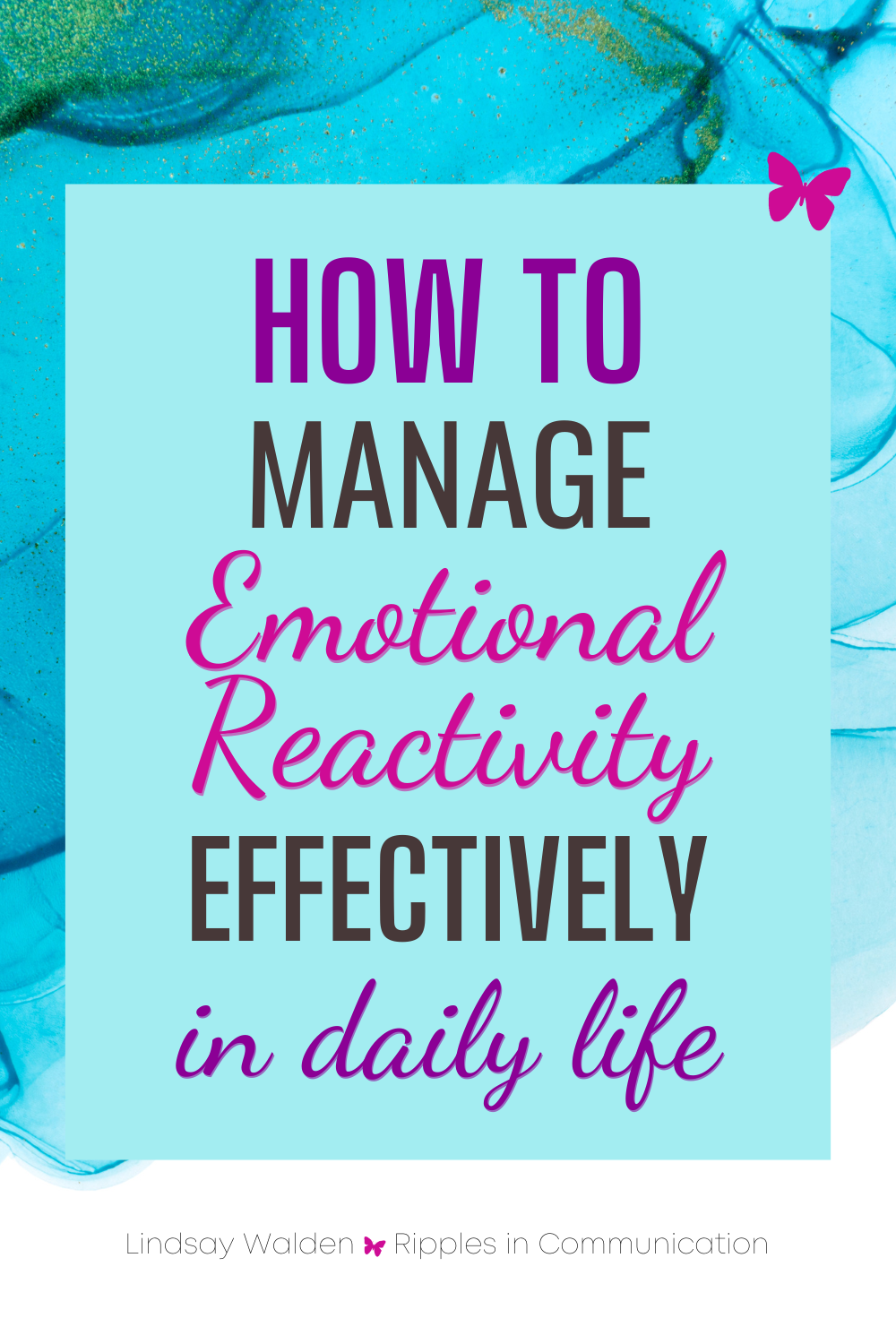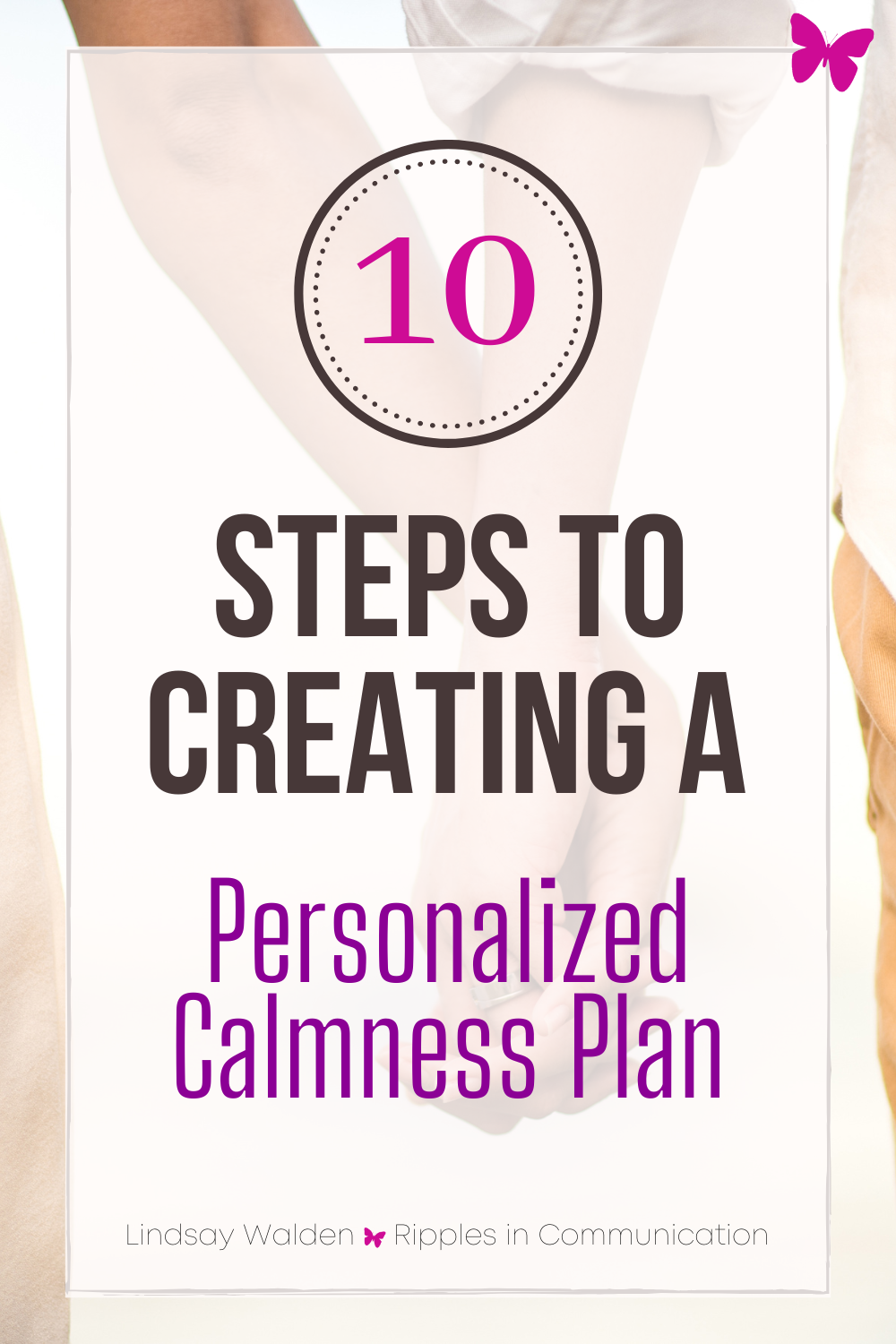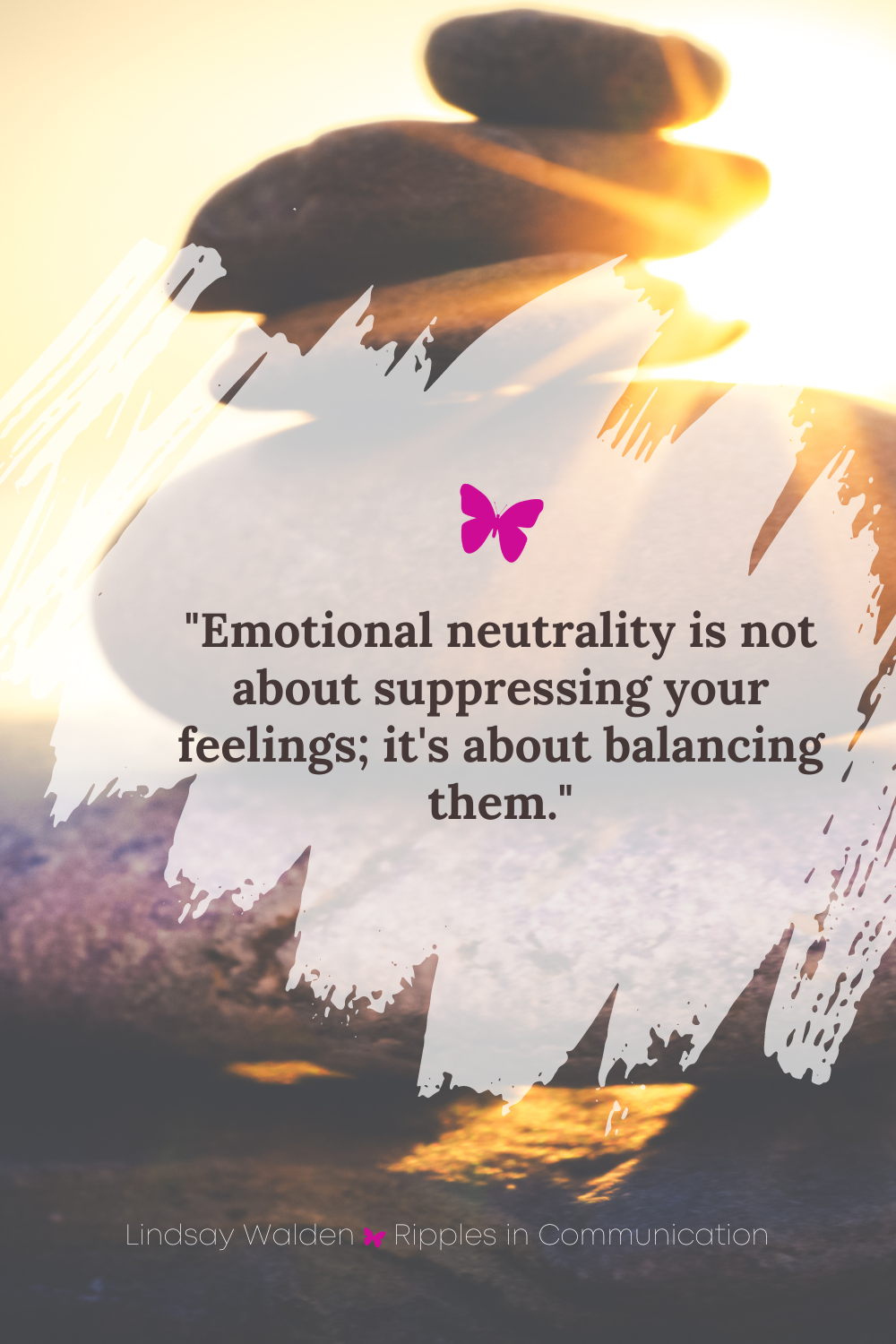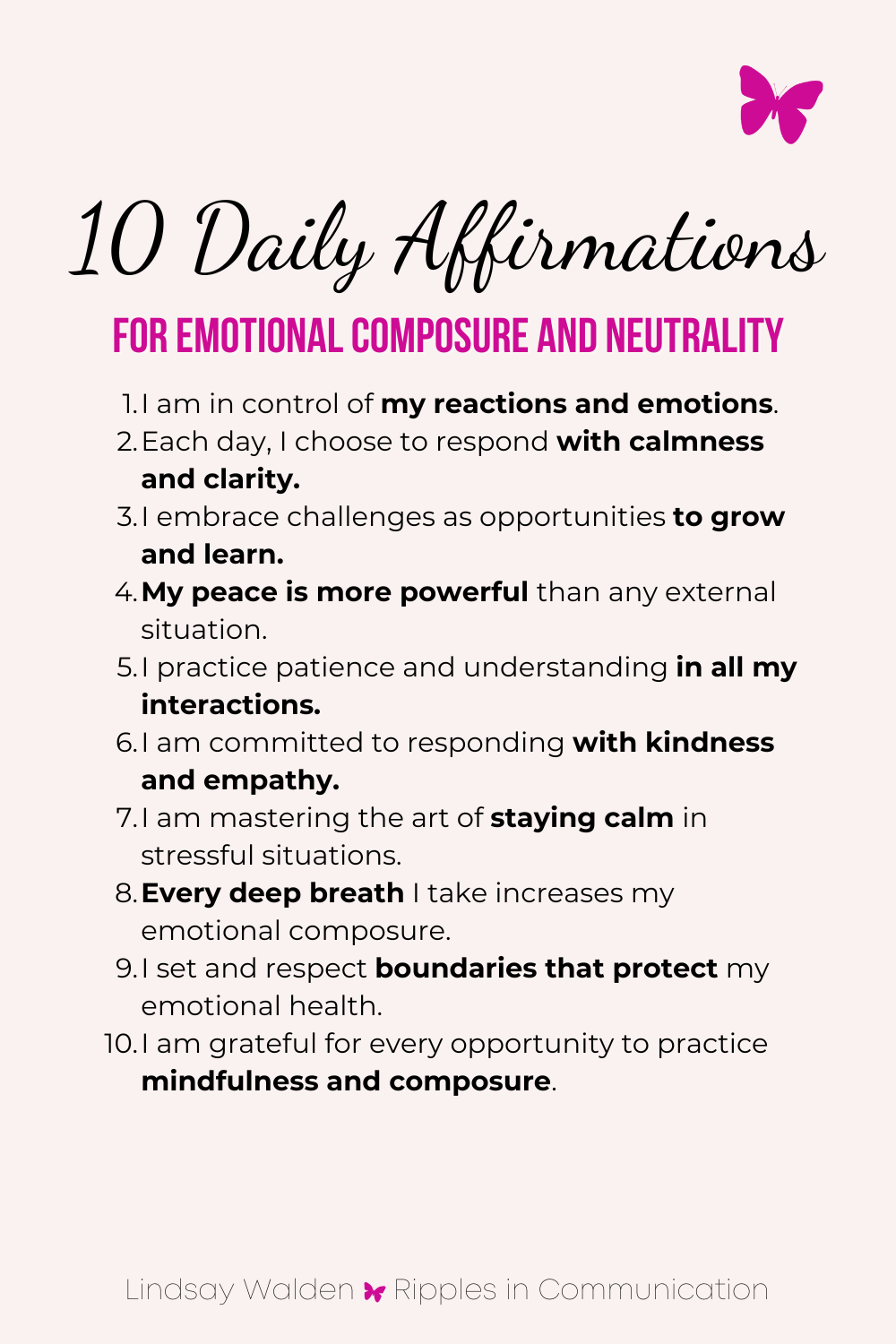How to Be Less Reactive and Short-Tempered
Mastering Calm: a Guide to Ending Reactivity
In today's fast-paced world, emotional reactivity has become a common challenge. It affects not only our personal connections but also our professional interactions. Emotional neutrality, stress management, and effective communication skills are essential tools for navigating this terrain. Many of us experience times when the slightest provocation can trigger a disproportionate response. This reactive state can strain relationships, impede honest conversations, and hinder self-awareness. By understanding our triggers and learning to manage our responses, we foster healthier, more resilient relationships. Achieving emotional composure requires practice and dedication. It involves setting boundaries, practicing practical mindfulness, and developing emotional intelligence. As we embark on this journey towards self-regulation, we unlock the potential for a more harmonious, centered life.
Key Takeaways:
Understanding Emotional Reactivity: It's crucial for cultivating stronger personal and professional relationships.
Embracing Emotional Neutrality: Tools like the composure pendulum by Chase Hughes can guide us towards balanced reactions.
Building Skills for Calm: Incorporating communication skills, setting boundaries, and practical mindfulness exercises are vital steps.
Have you gotten my FREE Relationship Communication Guide yet? Start building an authentic, conscious, and thriving relationship with your partner TODAY. Say goodbye to misunderstandings, conflicts, and missed opportunities for a deeper connection. These are the same tips and practical advice I give to my clients every day. With this guide, you'll be equipped to navigate any communication challenge and build a strong and fulfilling bond with your partner. Click the button below to enter your email address and I will send the guide to your inbox right away!
The Power of Emotional Neutrality
Many of us struggle with being short-tempered or reactive, a state where every small irritation can escalate into a full-blown conflict. However, the strategy to manage this doesn't involve burying our feelings. It hinges on mastering emotional neutrality, a concept distinct from the mere suppression of emotions. Emotional neutrality, inspired by Chase Hughes' teachings on the composure pendulum, encourages us to find a balance. This approach doesn't mean becoming impassive or indifferent. Instead, it's about maintaining an equilibrium between our emotional and rational selves. The composure pendulum illustrates this beautifully, positioning composure at the center of our emotional spectrum, with extremes of collapse and posturing on either side. By embracing emotional neutrality, we strive not for a lack of emotion, but for the freedom to experience our feelings without letting them control our actions or overshadow our logic.
Recognizing Your Triggers
Identifying your triggers is the first crucial step towards achieving emotional neutrality and managing reactionary behaviors effectively. It involves a deep dive into self-awareness, where you become a detective in your own life, searching for patterns that lead to those moments of high stress or anger. This process is not about blame but understanding. It's recognizing that certain situations, comments, or individuals might spark a short-tempered reaction. Whether it's a specific topic of conversation that hits too close to home or a type of behavior that you find disrespectful, understanding these triggers allows you to prepare and respond differently. By acknowledging what sets off your reactionary behaviors, you're taking a powerful step towards open communication, conflict resolution, and a healthier relationship foundation. Armed with this knowledge, you can start to approach these moments with practical mindfulness, setting boundaries that protect your emotional composure, and ultimately, fostering more honest conversations and intimacy in your relationships.
Discover effective strategies to manage emotional reactivity and enhance your daily interactions. Learn to stay calm and composed under pressure.
Steps to Achieve Emotional Neutrality
To embark on the journey towards emotional neutrality, one must first acknowledge the inevitable reality that feelings and reactions have their place. It's essential to validate these emotions without immediate surrender to reactionary impulses. This process begins by recognizing that emotional intensity doesn't necessitate impulsive responses. A central aspect involves creating a mental space where one can observe emotions without letting them dictate actions.
Identify Your Emotional Triggers: Begin by pinpointing the situations or interactions that typically ignite your short fuse. Awareness is a powerful tool in managing reactionary behaviors.
Pause Before Responding: When a trigger is activated, give yourself a momentary pause. This brief intermission allows you to gather your thoughts and approach the situation more calmly.
Apply the Composure Pendulum Concept: Inspired by Chase Hughes, visualize your emotional state on a pendulum swinging between collapse and posturing. Strive to find your equilibrium at the center, where emotional composure resides.
Engage in Honest Conversations: Open communication plays a vital role in addressing and preventing misunderstandings. Speak your truth, but with a calm and clear perspective.
Practice Mindful Reflection: Dedicate time to self-reflection and mindfulness. These practices promote a grounded awareness, enabling you to respond to stressors with emotional intelligence rather than impulsiveness.
Integrating these steps into your daily routine will empower you to manage stress, anger, and other intense emotions more effectively. By practicing emotional neutrality, you lay the groundwork for healthier, more meaningful connections with others and with yourself.
The Role of Honest Conversations
Open, honest, and direct conversations play a pivotal role in mitigating reactionary behavior. When we articulate our feelings openly, it creates an environment where misunderstanding dwindles. Such clarity in communication is instrumental in resolving conflict and building the foundation of a strong, healthy relationship. It fosters a sense of security, allowing partners to express themselves without fear of judgment or reprisal.
Engaging in genuine dialogue demands self-regulation and emotional composure. This approach encourages emotional neutrality, serving as a counterbalance to being short-tempered. As a couples and sex therapist, I've observed that addressing communication issues and past traumas openly can significantly impact intimacy and the overall health of a relationship. Practicing honest conversations has the power to transform your interactions, moving from reactionary responses to thoughtful communication, which ultimately strengthens the bond between partners.
Breathing Techniques for Immediate Calm
In the heat of the moment, when your fuse feels incredibly short, certain breathing techniques can be your anchor to composure. I've explored a variety of methods, but there's one that I find particularly powerful for anyone grappling with reactionary behaviors and seeking emotional neutrality. First and foremost, I urge you to try the 4-7-8 technique. This involves breathing in quietly through your nose for 4 seconds, holding the breath for 7 seconds, and then exhaling forcefully through your mouth for 8 seconds. This pattern helps in stress management and diffuses the immediacy of your reactions, giving you a chance to embrace a state of calm.
Moreover, engaging in deep diaphragmatic breathing can also significantly ease tensions. By allowing your breath to deeply fill your abdomen, not just your chest, you're sending a signal to your brain to calm down. This practice can be pivotal in self-regulation, bringing you back to a place of patience and away from short-tempered snaps. It's a cornerstone in the journey towards mastering emotional composure and building a healthier relationship with yourself and others.
Setting Boundaries for Healthier Interactions
In our journey toward emotional neutrality, we often overlook a critical component: setting boundaries. These are not just markers we put up to keep others out. They serve as a declaration of our personal values and emotional needs, thus aiding significantly in stress management and anger management. Establishing clear boundaries ensures that our interactions are grounded in respect and understanding.
Imagine this: You communicate your limits calmly and assertively. This act alone can prevent numerous situations that might trigger reactionary behaviors. It's about knowing when to say no or to request space, so we can maintain our composure. By doing so, we pave the way for healthier relationships, where open communication is not just encouraged but is a foundational element.
Boundary setting empowers us. It gives us the tools for conflict resolution and helps manage past traumas that might fuel our short-tempered responses. It fosters self-regulation and contributes to a strong relationship foundation. Through this practice, we learn not just to coexist but to thrive alongside our peers, partners, and colleagues.
Understanding the Impact of Past Traumas
Unresolved past traumas often set the stage for our current emotional landscape, steering us towards a state where reactionary behaviors and short-tempered responses become the norm rather than exceptions. These traumas, buried deep within our psyche, create a foundation on which communication issues in relationships can flourish, hindering our capacity for intimacy and open, honest conversations. Recognizing the tendrils of past events that shape our present reactions is crucial.
Seeking therapy or support plays a transformative role in healing these wounds. Through the therapeutic journey, individuals learn to navigate their past traumas with emotional intelligence and self-awareness, leading to a significantly improved ability for conflict resolution and stress management. This process unveils the strength of emotional neutrality as a tool for self-regulation, providing a pathway out of the cycle of reactivity. Engaging in honest conversations about one's experiences, empowered by the guidance of a therapist, lays a strong, healthy foundation for future interactions, both with oneself and others.
Unlock the secrets to achieving emotional neutrality. Get practical tips for reducing stress and maintaining balance in your life.
Practical Mindfulness Exercises
I've seen firsthand how becoming entrenched in reactionary behaviors can disrupt peaceful living. Emotional intelligence is key in breaking this cycle. Mindfulness, a cornerstone of emotional composure, offers practical methods for maintaining tranquility. Here, I'll share mindfulness exercises tailored for enhancing self-regulation and fostering a state of emotional neutrality.
Focus on your breath: This timeless technique is monumental for stress management. Inhale deeply through your nose, hold for a count, and exhale slowly through your mouth. Repeat until you sense your anger management challenges waning, cultivating an environment where open communication and honest conversations thrive.
Grounding yourself: When your fuse feels short, connect with your physical senses. Name five things you can see, four things you can touch, three things you can hear, two things you can smell, and one thing you can taste. This helps draw you back from reactionary behaviors, paving the way for healthier relationship foundations and conflict resolution.
Engage in guided imagery: Visualize a place that embodies tranquility for you. Immerse yourself in this scene, tapping into practical mindfulness to quell the fires of a short temper. Through such visualizations, achieving emotional neutrality becomes more accessible, enhancing your capacity for setting boundaries and managing reactions constructively.
Integrating these exercises into daily routines can be transformative, encouraging self-awareness while reducing reactionary tendencies. It’s a journey towards mastering calm, ensuring that intimacy in relationships and personal contentment are within reach.
Communication Skills for Emotional Neutrality
In nurturing emotional neutrality, one must lean heavily into advanced communication skills. We often trip over our words when our hearts race with unfiltered anger or frustration. By recognizing this, we embark on a journey towards meaningful connections and healthier discourse.
The first stride involves grounding oneself. Prior to engagement, a deep, focused breath can serve as a bridge to emotional composure. Acknowledge the storm inside but ensure it doesn't sweep you away. This technique, drawn from practical mindfulness, fosters an environment where open communication thrives.
Another key factor is active listening. It's not merely about waiting for your turn to speak. Rather, it involves truly hearing, understanding, and reflecting on the other person's perspective. This approach diminishes reactionary behaviors and lays the groundwork for honest conversations.
Lastly, remember the importance of setting boundaries. Articulating your needs and limits clearly can prevent the escalation of conflict. These boundaries are the pillars of a healthy relationship foundation, enabling us to manage stress, resolve conflicts, and cultivate intimacy in relationships effectively.
Creating a Personalized Calmness Plan
Achieving emotional neutrality and mastering calm in the face of stress requires a dedicated plan tailored to your unique triggers and life circumstances. I have seen firsthand how unresolved past traumas and daily pressures can erode one's sense of composure, leading to reactionary behaviors that damage relationships and self-esteem. Through my practice, the journey to emotional intelligence has always involved first acknowledging the role of these triggers, then actively engaging in self-awareness practices to identify them.
Creating a personalized calmness plan starts with recognizing your triggers and implementing strategies like practical mindfulness and breathing techniques, ensuring you're not left vulnerable to short-tempered reactions. Incorporating the teachings of Chase Hughes on the composure pendulum, you'll learn to find your balance between emotional collapse and posturing, establishing a foundation for open communication and honest conversations within your relationships. This process is not just about managing stress or anger; it's about building a new relationship with yourself and your emotional responses. By setting boundaries and adopting emotional composure as part of your daily life, you pave the way for healthier interactions and a more grounded existence.
Discover the power of emotional neutrality to transform your life. Learn how balancing your emotions can lead to peace and improved well-being.
10 Steps to Creating a Personalized Calmness Plan
Creating a personalized calmness plan is essential for anyone looking to reduce reactivity and enhance emotional stability in their day-to-day life. Here’s how you can build and implement an effective plan tailored specifically for you:
Self-Assessment: Begin by identifying your emotional triggers. Reflect on past incidents that have led to heightened reactivity or anger. Note the circumstances and people involved, the emotions felt, and how you reacted. Understanding these triggers is crucial for the next steps.
Define Clear Objectives: What do you hope to achieve with your calmness plan? Setting clear, realistic goals such as "respond more thoughtfully during stressful interactions" or "maintain composure during work meetings" can provide direction and motivation.
Develop Coping Strategies: Based on your triggers and objectives, develop specific strategies to manage your reactions. This might include:
Breathing Exercises: Techniques like the 4-7-8 breathing method can help control physiological reactions to stress.
Mindfulness Practice: Regular mindfulness can increase your awareness of emotional states and provide you with the control to choose how you react.
Take Some Alone Time: When triggered, give yourself some time to be by yourself. Even a few minutes away can help you regain your composure and respond more appropriately.
Incorporate Routine Checks: Set specific times to review your emotional state and practice your coping strategies. This could be a morning meditation to set the tone for the day or a nightly journaling session to reflect on your emotional responses and progress.
Seek Feedback: Engage close friends, family members, or a therapist who can provide honest feedback about your progress. They can offer insights into changes they’ve observed and provide support.
Adjust and Evolve: Your calmness plan is not set in stone. As you practice your strategies and learn more about your emotional patterns, make adjustments. Evolving your plan based on what is or isn’t working is key to long-term success.
Celebrate Progress: Recognize and celebrate improvements, no matter how small. Acknowledging your successes can boost your motivation to continue.
Educational Enhancement: Continuously educate yourself about emotional intelligence and stress management. Reading books, attending workshops, or listening to podcasts on these topics can provide new techniques and insights. You can see my list of favorites here
Physical Health: Incorporate physical activity into your routine, as exercise can significantly impact your emotional health, reducing stress and increasing your ability to manage anger.
Professional Guidance: If necessary or if things get to be too much, please consider professional help. As a licensed sex and couples therapist specializing in cognitive-behavioral therapy, I can offer tools and strategies that specifically target reactivity and help in developing a robust personal calmness plan.
Learning from Relapses: Growth Mindset
Embracing a growth mindset means recognizing that the path to mastering emotional neutrality, managing stress, and enhancing our communication for healthier relationships will have its ups and downs. We understand that setbacks in controlling reactionary behaviors or moments of being short tempered are integral to the learning curve. Practicing self-regulation, and engaging in honest conversations about our triggers, can sometimes lead us to rediscover past traumas or stumble upon new stressors. These instances aren't failures but opportunities for deeper self-awareness and emotional intelligence.
We've dived into the realms of practical mindfulness, setting boundaries, and the vital art of open communication, all aiming to build a solid relationship foundation. Yet, the journey towards achieving emotional composure, as devised by figures like Chase Hughes with the composure pendulum, is continuous. Each relapse offers a unique insight into our conflict resolution strategies and beckons us to refine them further. It prompts us to revisit our personalized calmness plan, adding more robust self-regulation and anger management techniques or reshaping our approach to stress management.
The quest for balance and composure isn't linear; it wends through experiences of success and moments of realization. By fostering a growth mindset, we honor every phase of our journey towards ending reactivity, empowering ourselves to remain steadfast in the pursuit of a harmonious and intimate relationship with ourselves and others.
The Journey to Composure and Balance
In our journey toward emotional neutrality, we've navigated through identifying triggers, practicing mindfulness, and enhancing our communication skills. These steps, foundational in achieving a state of composure, empower us beyond mere conflict resolution. They lead us to a place where stress and anger management become second nature, facilitating healthier, more intimate relationships.
Embracing this path has taught us the importance of honest conversations, both with ourselves and others. Open communication, grounded in self-awareness and emotional intelligence, has proved indispensable. It aids not just in tempering reactionary behaviors but in building a strong, healthy relationship foundation.
Chase Hughes' concept of the composure pendulum, illustrating the balance between collapse and posturing, has been a guiding light. It underscores the significance of self-regulation and setting boundaries, not as constraints, but as liberators. These principles allow us to navigate intimacy in relationships and past traumas with a level head and a steady heart.
Moreover, the practice of practical mindfulness steadies our quicksilver reactions, granting us the serenity to face provocations with grace. By focusing on emotional composure rather than capitulating to short-tempered outbursts, we carve out a space for growth and healing.
To conclude, our endeavor to master our emotions and reduce reactionary behaviors is more than an exercise in stress management. It is a bold stride towards self-empowerment and liberation. It's a promise to ourselves that, despite the trials, we are capable of fostering an environment of open communication and healthy relationships. Emotional neutrality, thus, isn't merely a concept; it's a transformative practice that equips us to face life's challenges with poise and to engage with the world from a place of balanced strength and profound understanding.
Empower your daily routine with these 10 powerful affirmations designed to enhance emotional composure and reduce reactivity. Embrace calmness and balance in your personal and professional life today.








